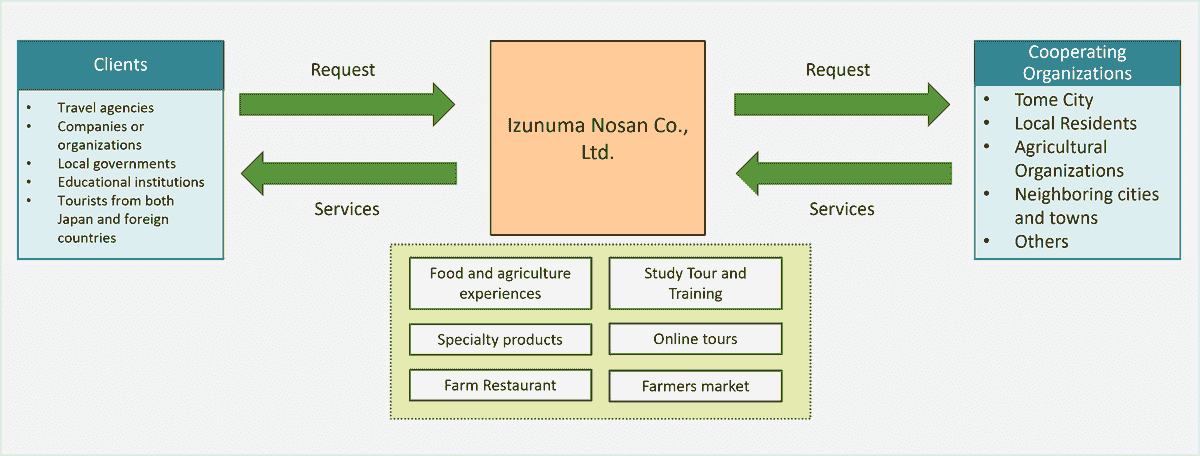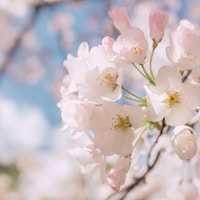

Izunuma Nosan Co., Ltd.
- …

Izunuma Nosan Co., Ltd.
- …

Educational Tour
Since our founding in 1988, our company has been engaged in agricultural production, manufacturing processed products such as ham and sausages, and operating farmers markets and restaurants. To increase the number of travelers staying in the region, we established the “Food and Agriculture Experience Network Tome Council” in 2017 and began full-scale efforts in farm stays.
With the cooperation of over 100 farmers, we actively promote “farm stays closest to the producers” through various exchanges and collaborations with experience farms and farm stay host farmers.
Please consider utilizing our area when planning educational trips focused on nature, food, agriculture, and cultural exchange.
About Tome City, Miyagi Prefecture
- Tome City is located in the northeastern part of Miyagi Prefecture. To the north, it borders Iwate Prefecture, to the west it adjoins Kurihara City, and to the east it neighbors Minamisanriku Town.
- The city covers an area of 536.09 square kilometers, which accounts for 7.36% of the total area of Miyagi Prefecture.
- The western part of the city is a hilly area, while the northeastern part consists of mountainous terrain. In between, it features the vast, flat, and fertile Tome plains.
- Tome is one of the leading grain-producing areas in the prefecture and is particularly famous as the main production area for Miyagi rice varieties such as "Sasanishiki" and "Hitomebore." Livestock farming is also thriving in the region.
- Toyoma Town, often referred to as "Miyagi's Meiji Village," is home to several historical buildings from the Meiji period, including the Education Museum, as well as the Mizusawa Prefectural Office Memorial and The Police Museum, which still retain their historical appearance.
- Additionally, the northwestern part of the city is home to Ramsar Convention wetlands such as Izunuma Lake, Uchinuma Lake, and Naganuma Lake, where swans and geese can be seen migrating. To the south lies the Byodonuma, further contributing to the city's reputation as a "water town."
About Izunuma Lake and Uchinuma Lake
Izunuma Lake and Uchinuma Lake are vast wetlands that spans across Tome City and Kurihara City in Miyagi Prefecture, covering an area of 491 hectares (369 hectares for Izunuma and 122 hectares for Uchinuma). The water surface rarely freezes even in winter, and the area is abundant in plants, fish, and insects, making it one of the largest stopover sites for migratory birds in Japan. This has attracted many birdwatching enthusiasts.
In the summer, the water surface of Izunuma-Uchinuma becomes covered with lotus leaves, and the flowers bloom profusely, creating a scene reminiscent of a paradise. Since being designated as a Ramsar Wetland (*) in 1985, active efforts have been made to protect this rich natural environment.
*Ramsar Convention: This convention was signed in Ramsar, Iran, in 1971. The official name in Japan is "Ramsar Convention on Wetlands of International Importance Especially as Waterfowl Habitat."
Exploring Biodiversity and Nature-Positive Approaches through Field Experiences
Lake Izunuma and Lake Uchinuma are rich in natural beauty, but in recent years they have faced various environmental issues such as water quality deterioration, the influx of invasive fish species, and a decline in biodiversity.
Until the 1970s, the lakes were clear enough to see the bottom, supporting plants and animals that thrive in clean water. However, as development and farmland expansion progressed in the surrounding areas, residential wastewater and muddy runoff from agricultural land began flowing into the lakes. This caused eutrophication, turning the lakes murky.
Currently, led by the Miyagi Prefecture Izunuma-Uchinuma Environmental Conservation Foundation, local residents, volunteers, and research institutions nationwide are working together on various conservation efforts.
Meanwhile, as part of our nature-positive activities, we are practicing a farming method called "Fuyumizu Rice Field (Winter water-retained rice field)." The Fuyumizu Rice Field (Winter water-retained rice field) is a technique where rice fields are kept flooded during the winter. Normally, after the rice harvest, the fields are left dry, but by keeping them flooded, waterfowl such as white-fronted geese can safely rest and feed. The droppings from the waterfowl and the leftover rice straw are broken down by small organisms, creating natural compost. This allows us to cultivate fields without relying on pesticides or chemical fertilizers.
This farming method truly benefits both biodiversity and crop production.
In our educational tour programs, we offer on-site experience plans focused on the environmental conservation activities mentioned above, including Fuyumizu Rice Field (Winter water-retained rice field). We can also provide pre-visit and post-visit learning sessions upon request. Additionally, we can accommodate combinations of agricultural experiences, cooking workshops, and farm stays. Please feel free to contact us for more information.
Guidelines for Acceptance:
From 5 to 50 participants per session.
Please contact us for groups larger than 50.

Learning Plan Using Fuyumizu Rice Fields (Winter water-retained rice fields)
1. Pre-visit Study: Biodiversity and Agriculture in Tome City
2. On-site Learning: Farming Activities and Wildlife Surveys
3. Post-visit Study: Discussion on What We Can Do to Sustain Biodiversity and Agriculture

Learning Plan on the Ramsar Convention and Migratory Birds
1. Pre-visit Study: Overview of Lake Izunuma, Lake Uchinuma, and Migratory Birds
2. On-site Learning: Observing Migratory Birds Taking Off and Returning to Roost, Visiting the Sanctuary Center, and Participating in Clean-Up Activities at Lake Izunuma and Lake Uchinuma
3. Post-visit Study: Discussion on the Future of Japan’s Top Migratory Bird Habitat and What We Can Do

Plan to Learn About Adding Value to Local Resources and the Rural Industry Model
1. Pre-visit Study: Overview of the Sixth-sector Industrialization of Agriculture and Food-Agriculture Experiences
2. On-site Learning: Facility Tours and Experiences Led by Local Residents
3. Post-visit Study: Discussion on What We Can Do to Create Sustainable Rural Industries
Lake Izunuma and Lake Uchinuma Ecosystem Learning Centers
Around Izunuma and Uchinuma, there are three visitor centers called "Sanctuary Centers." These centers feature exhibition areas about the natural environment and viewing spaces where you can look over the wetlands. We highly encourage you to visit. Additionally, each center holds seasonal events that allow you to experience the charm of Izunuma and Uchinuma. Be sure to check their website for more information.

Miyagi Prefecture Izunuma-Uchinuma Sanctuary Center (Bird House)
This facility is characterized by a building designed to resemble a swan. The first floor features various exhibits, while the second floor has a viewing space where you can observe Izunuma and migratory birds.
[Highlight]
Miyagi Prefecture Izunuma-Uchinuma Sanctuary Center, operated by the Miyagi Prefecture Izunuma-Uchinuma Environmental Conservation Foundation, has launched an international collaborative project called the "Swan Project" in partnership with China’s Druid Technology and others. For more details, visit the Swan Project website.

Tome City Izunuma-Uchinuma Sanctuary Center (Freshwater Fish House)
This facility is themed around the "water" of the Izunuma ecosystem. The first floor features an aquarium space where you can observe freshwater fish, while the second floor displays fishing tools, photos, and other exhibits.

Kurihara City Izunuma-Uchinuma Sanctuary Center Tsukidate (Insect House)
This facility is themed around the "insects" of the Izunuma ecosystem. The first floor features insect specimens and video displays, while the second floor has a viewing space where you can observe Uchinuma.
Nearby Accommodations
For details such as reservations, please contact each accommodation directly.
Regarding farm stay accommodations, we can offer proposals in cooperation with the Tome City Green Tourism Promotion Council and the Kurihara City Farm Stay Promotion Council. Please contact us for more details.
Izunuma Wetland Exchange Center
This is the closest accommodation to Izunuma. From the facility, you can watch migratory birds take off in the morning and return to their roosts in the evening. The center offers various experiences such as camps for children and training sessions. It also features sports areas for tennis and 5-a-side soccer, as well as areas for barbecues and traditional Japanese 'imo-ni' taro and meat stew gatherings.
Naganuma Rowing Clubhouse
This is a paid, simple accommodation facility located on the shores of Naganuma Lake, designed for sports organizations and community development, as well as promoting local engagement. In addition to sports training camps, it is also available for various events and seminars.
Annex Hotel Abe
This hotel is located just a 15-minute drive from Izunuma and the Kurikoma Kogen Station on the Tohoku Shinkansen. It offers a homey, welcoming atmosphere where guests can enjoy homestyle dishes made with local ingredients. The hotel also features a co-working space and rental bicycles, adding to its charm.
Tenohira-ni Taiyo-no Ie (pronounced "ee-eh") (House of the Palm of the Sun)
It was built to support children affected by the Great East Japan Earthquake and to revitalize the disaster-stricken area. Currently, it serves as a simple accommodation facility, where visitors can enjoy lodging and various activities. Located in Miyagi's Meiji Village in Toyoma Town, it is also convenient for nearby sightseeing.
What Makes Our Company Unique
- We can offer story-driven programs themed around 'agriculture' and 'food,' which are often difficult to organize in typical tourist destinations.
- In addition to seeing and listening, we incorporate experiential elements, with guides sharing the charm of farming villages in an enjoyable and easy-to-understand way.
- Our company is registered as a 'Travel Service Agent' in Miyagi Prefecture (Miyagi Prefecture Governor Registration No. 27, registered on April 8, 2021). When organizing tours through travel agencies, our company acts as the regional concierge, handling all coordination from pre-tour arrangements to the completion of the tour through a single point of contact.

Download Materials
This is our company introduction material.
You do not need permission to download and use it for personal or household purposes. However, prior approval from the copyright holder (our company) is required for reproduction or secondary use for business purposes. Please contact us for inquiries.
Inquiries
If you have any questions or concerns, please feel free to contact us.
Izunuma Nosan Co., Ltd.
宮城県登米市迫町新田字前沼149-7From Monday to Saturday
9:00 a.m. to 5:30 p.m.Phone Number: +81-220-28-2986Select...










